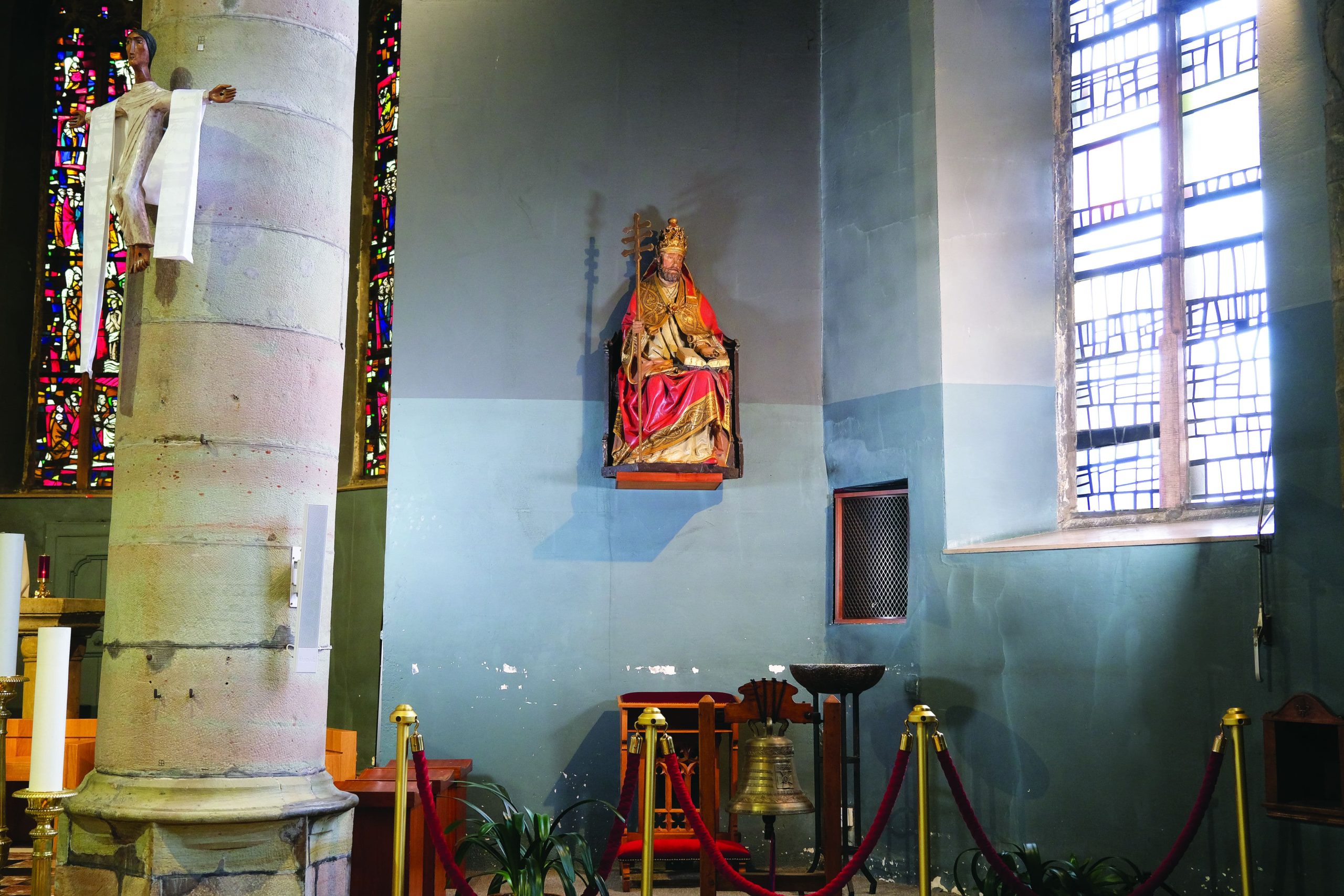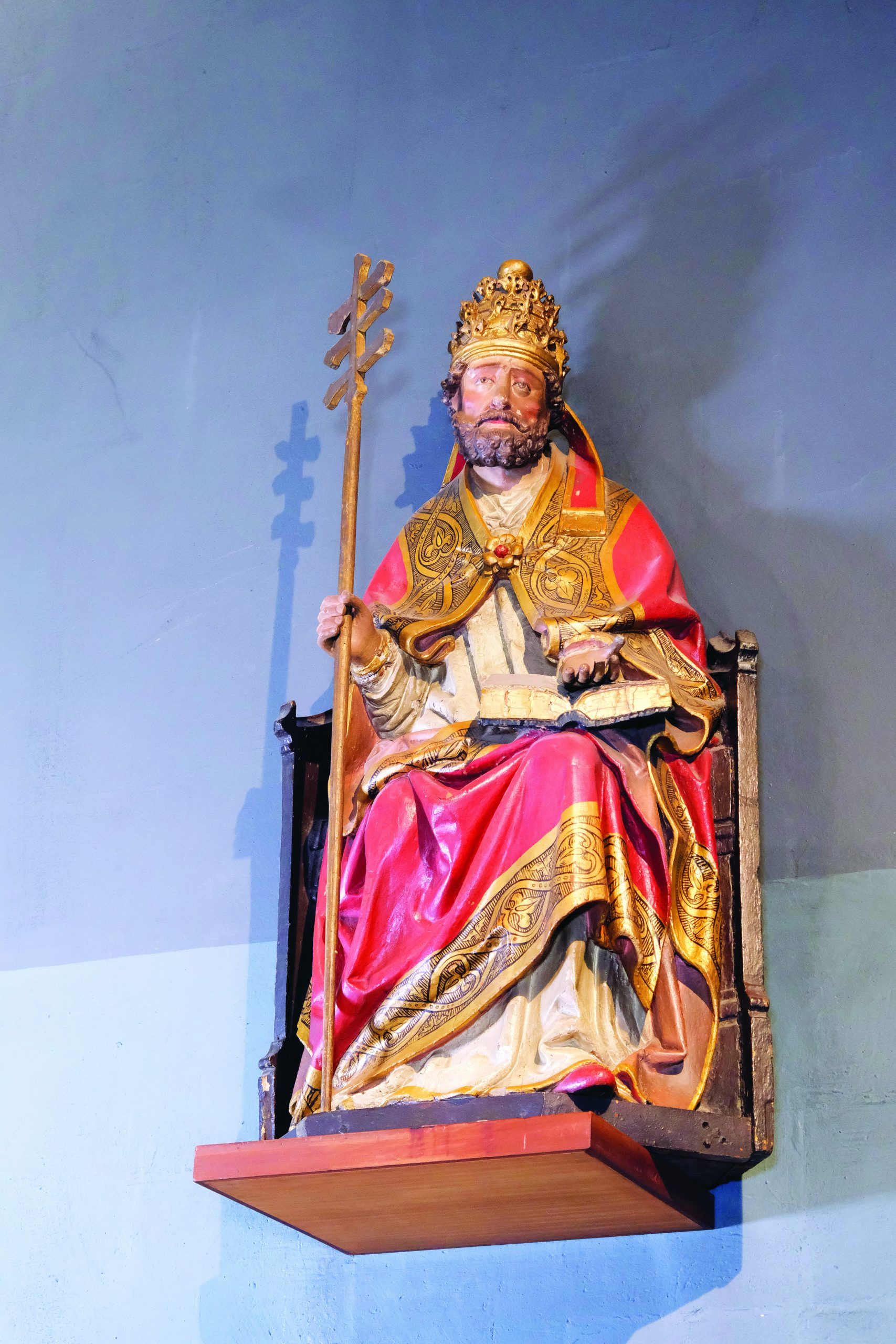La statue de saint Pierre
Saint Pierre était l’un des apôtres de Jésus les plus en vue. Malgré son importance, Pierre est peu documenté par les sources. De son vrai nom Simon, Pierre était pêcheur avec son frère André, lui aussi apôtre du Christ. Après une pêche infructueuse, ils deviennent tous les deux des disciples de Jésus lorsque celui-ci a fait miraculeusement apparaître une multitude de poissons dans leurs filets. Pierre a été le premier évêque de Rome, ainsi que le premier pape : on le représente souvent en tant que tel dans l’art.
La statue date du début du 17e siècle et mesure 130 cm de haut. Pierre est représenté assis, tenant la croix papale et la Bible. À l’origine, un coq se trouvait dans sa main gauche, en référence à la phrase prononcée par le Christ : « Avant que le coq chante deux fois, tu m’auras renié trois fois », prédisant ainsi que Pierre le renierait, par peur d’être mis à mort par les autorités.
Pierre est richement habillé d’une chape, longue cape portée dans la liturgie catholique. La couleur d’origine n’est pas connue, le rouge et l’imitation de broderies au fil d’or étant le fruit d’un repeint du 19e, voire du début du 20e siècle. Sur la tête, il porte la tiare pontificale, soit la triple couronne portée par les papes, symbole du pouvoir donné par Jésus à saint Pierre.
Het standbeeld van Petrus
Petrus was een van de meest prominente apostelen van Jezus. Ondanks zijn belang is Petrus weinig gedocumenteerd in de bronnen. Petrus, wiens echte naam Simon was, was een visser, net zoals zijn broer Andreas, ook een apostel van Christus. Na een mislukte vistocht werden zij beide volgelingen van Jezus toen deze op wonderbaarlijke wijze een grote hoeveelheid vis in hun netten deed verschijnen. Petrus was de eerste bisschop van Rome en tevens de eerste paus. In de kunst wordt hij dan ook vaak in die hoedanigheid afgebeeld.
Het beeld dateert uit het begin van de 17e eeuw en is 130 cm hoog. Petrus wordt hier zittend afgebeeld, met het pauselijk kruis en de Bijbel in de hand. Oorspronkelijk hield hij een haan in zijn linkerhand. Daarmee werd verwezen naar de woorden van Christus: « Voordat de haan twee keer kraait, zul je me drie keer verloochend hebben », waarmee hij voorspelde dat Petrus hem zou verloochenen uit angst door de autoriteiten ter dood gebracht te worden.
Petrus is rijkelijk gekleed in een kap, een lange mantel die in de katholieke liturgie wordt gedragen. De oorspronkelijke kleur is niet bekend; het rood en het borduurwerk met imitatiegouddraad zijn het resultaat van een herschildering in de 19e of misschien zelfs begin 20e eeuw. Op zijn hoofd draagt hij de pauselijke tiara, de drievoudige kroon die pausen dragen en die de macht symboliseert die Jezus aan Petrus heeft gegeven.
The statue of St. Peter
St. Peter was one of the most prominent apostles of Jesus. Despite his importance, Peter is little documented in the sources. Peter, or Simon by his real name, was a fisherman, as was his brother Andrew, also an apostle of Christ. After an unsuccessful fishing trip, they both became followers of Jesus when he miraculously caused a multitude of fish to appear in their nets. Peter was the first bishop of Rome, as well as the first pope: he is often depicted as such in art.
The statue dates from the early 17th century and is 130 cm high. Peter is shown seated, holding the papal cross and the Bible. Originally, a cockerel used to be in his left hand, thus referring to Christ’s words: « Before the rooster crows, you will deny me three times », thus predicting that Peter would disown him for fear of being put to death by the authorities.
Peter is richly dressed in a cope, a long cloak worn in the Catholic liturgy. The original colour is not known, the red and the imitation gold thread embroidery being the result of a repainting in the 19th or even early 20th century. On his head he wears the papal tiara, the triple crown worn by popes, symbolising the power given by Jesus to St Peter.


